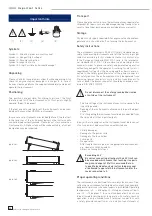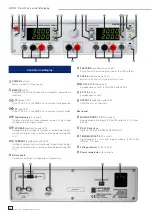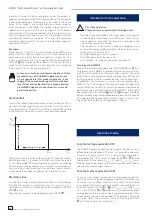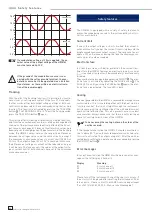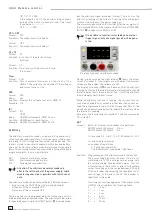
28
Subject to change without notice
R e m o t e c o n t r o l
OP1 CV1 CC2 RM1
If the outputs are off, the answer string contains
instead of the status of channels I and II two times
three dashes (––– –––).
OP0 ––– ––– RM1
OP1 + OP0
Format: OP1
Function: The outputs are switched on.
Format: OP0
Function: The outputs are switched off.
SF + CF
Format: SF
Funktion: Activation of the electronic fuse.
(Set
fuse)
Format: CF
Funktion: De-activation of the electronic fuse.
(Clear
fuse)
Clear
Format: CLR
Function: This command interrupts all functions of the
HM8143. The outputs are switched off, the voltages
and currents are set to 0.
VER
Format: VER
Reply:
x.xx
Function: Displays the software version of HM8143.
Example: 1.15
ID?
Format: ID?
*IDN?
Reply:
HAMEG Instruments, HM8143,x.xx
Function: HAMEG device identifi cation
Example: HAMEG Instruments, HM8143,1.15
Arbitrary
The arbitrary waveform mode can be used for generation of
virtually any desired waveforms. For this purpose, a table com-
prising up to 1024 voltage and time values can be defi ned. This
table is stored in nonvolatile memory with a backup battery,
and is not lost for several days when the instrument is powered
down. The following commands are available for operating and
programming this function by interface:
ABT
Transfer of arbitrary values
RUN
Start waveform generation
STP
Stop waveform generation
STOP
Attention: The arbitrary waveform mode only
effects the left channel of the power supply; rapid
waveform generation is possible with this channel
only.
The arbitrary mode can be terminated by 3 different means:
– By pressing the OUTPUT key (only in mixed-mode)
– By means of the command STP
– By means of the command OP0
While a waveform is being generated, the front panel controls
are disabled, except in mixed mode. The arbitrary mode can be
terminated by pressing the OUTPUT button in mixed mode,
but the arbitrary-signal proceeds internal. This also has the
effect of switching off the outputs. Pressing this button again
switches the outputs of the power supply on.
The waveform generation starts either after the receiption of
the command RUN or if the signal at the BNC-socket (TRIGGER
IN/OUT ) changes from HIGH to LOW.
STOP
If the arbitrary-function is started by an external
trigger signal, only one signal period will be gene-
rated.
Display of channel I in arbitrary mode
During arbitrary mode the right display shows the actual
values of channel II, if the outputs are activated or the nominal
values are displayed of the outputs are offf.
The display of channel II
shows 8 dashes. After the arbitrary
function has fi nished, the arbitrary mode is left automatically and
the left display shows the values set. A re-start of the arbitrary
function begins whith the fi rst value.
While the arbitrary function is running, the current limit set
cannot be changed. The current in either direction cannot ex-
ceed the programmed value. In order to prevent jitter of the
waveform, no data should be transferred via the interface while
the function is running.
Exception: the terminating command STP and the commands
OP1 and OP0.
ABT
Format: ABT:
<
list of values
>
N
<
number of repetitions
>
ABT:tVV.mVmV tVV.mVmV .... Nn or
ABT
:
tVV.mVmV tVV.mVmV .... Nn
t = time code 0–9, A, B,C, D, E, F; VV.mVmV = 0–30 V
N = end of table character
n = number of repetitions
n =
0 : Continuous repetition
n =
1-255: Waveform is repeated 1-255 times
Function: Programming of the arbitrary waveform function.
The power supply permits creation of a data list
containing up to 1024 voltage values along with
the corresponding time duration values. This list
is transferred in the form of a series of alternating
values for voltages in the range between 0.00 and
30.0 V and codes representing the time duration of
each voltage; at the end of the list, the number of
repetitions is indicated.
How long each voltage appears at the outputs of the
HM8143 is derived from the following table:
0
h
=
100
μs
1
h
= 1
ms
2
h
= 2
ms
3
h
= 5
ms
4
h
=
10 ms
5
h
=
20 ms







